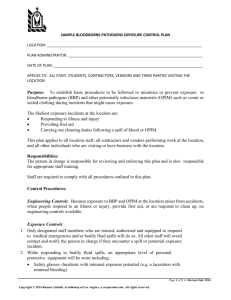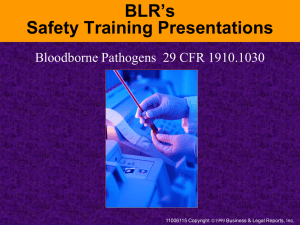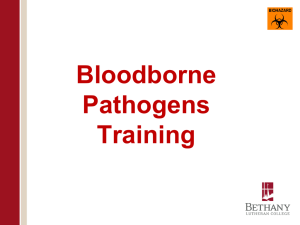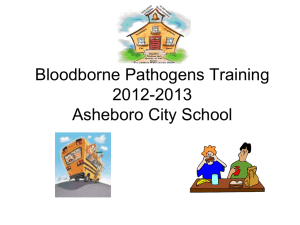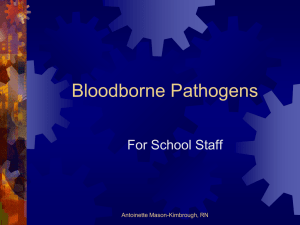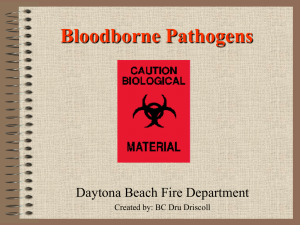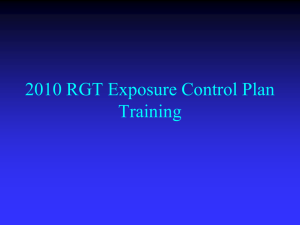Bloodborne Pathogens Forms and Resources
advertisement
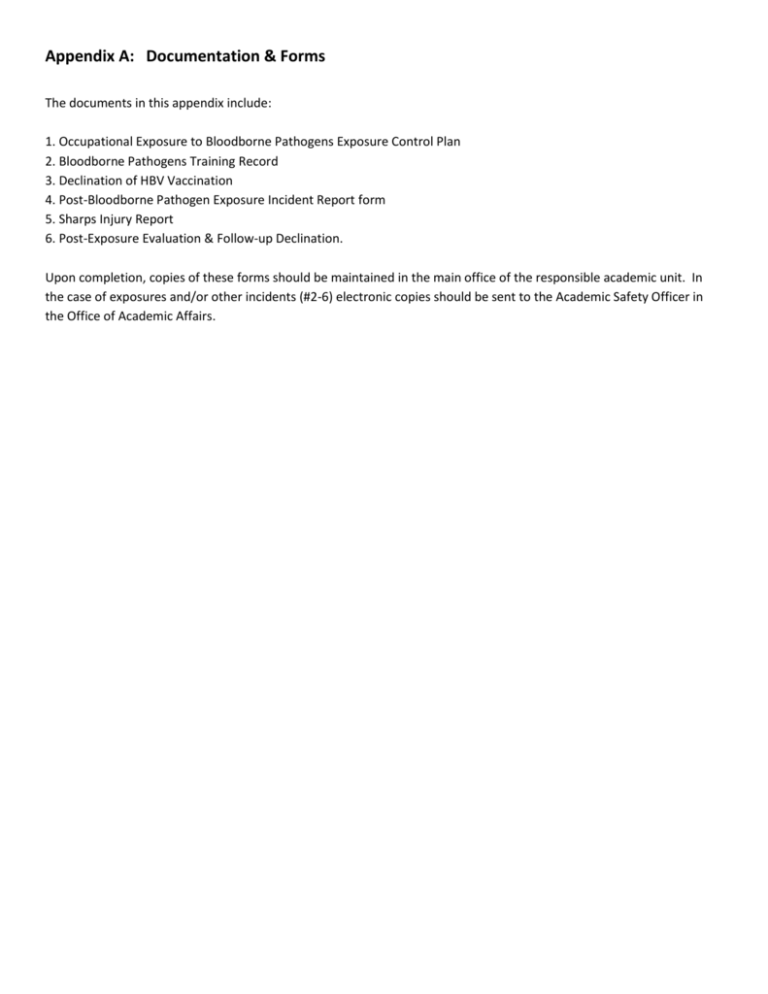
Appendix A: Documentation & Forms The documents in this appendix include: 1. Occupational Exposure to Bloodborne Pathogens Exposure Control Plan 2. Bloodborne Pathogens Training Record 3. Declination of HBV Vaccination 4. Post-Bloodborne Pathogen Exposure Incident Report form 5. Sharps Injury Report 6. Post-Exposure Evaluation & Follow-up Declination. Upon completion, copies of these forms should be maintained in the main office of the responsible academic unit. In the case of exposures and/or other incidents (#2-6) electronic copies should be sent to the Academic Safety Officer in the Office of Academic Affairs. Department Prepared by Occupational Exposure to Bloodborne Pathogens Exposure Control Plan In accordance with the OSHA Bloodborne Pathogens Standard, 29 CFR 1910.1030 Purpose The Exposure Control Plan is designed to eliminate or minimize work-related exposure by identifying potentially exposed employees, to human blood or other infectious body fluids. In 1992, the Occupational Safety and Health Administration (OSHA) enacted the Bloodborne Pathogens Standard codified as 29 CFR 1910. 1030. The purpose of the standard is to protect workers from anticipated exposures to bloodborne pathogens including Hepatitis B Virus (HBV) and Human Immunodeficiency Virus (HIV). Review and Update of the Bloodborne Pathogens Exposure Control Plan This Exposure Control Plan will be reviewed and updated at least annually by the IBC in consultation with the Academic , Facility, and Chemical Safety Officers, and when necessary to reflect new or modified tasks and procedures. 1. Exposure Determination OSHA requires employers to determine which employees may incur occupational exposure to blood or other potentially infectious materials. Exposure determination is made without regard to the use of personal protective equipment. Job Classifications in which some employees have occupational exposure and the tasks or procedures that would cause occupational exposure: 2. Method of Implementation Institutional Biosafety Committee, in consultation with the Faculty, Chemical Safety, and Academic Safety Officers, have developed this Occupation Exposure Control Plan. The IBC, Academic Safety Officer, Facility Safety Officer, and Chemical Safety Officer are responsible for the following: Implementing the plan and developing site specific policies and procedures and ensuring compliance. Reviewing and updating the Exposure Control Plan at least annually, and when necessary to reflect new or modified tasks and procedures, and to reflect new or revised employee positions that affect occupational exposure. Monitoring exposure control in their respective areas. Application of universal precautions Appropriate work practices and engineering controls The Chemical Safety Officer is available to assist with development of the exposure control plan, employee training and other consultative roles as related to the OSHA standard. A copy of this plan will be accessible to all employees via myBellarmine. Copies of the plan are also available online at the Institutional Biosafety website. 3. Compliance Methods A. Universal Precautions: Universal Precautions were developed by the Centers for Disease Control to help prevent the transmission of bloodborne diseases in the work place. Under universal precautions, all human blood and other potentially infectious materials (OPIM) are considered infectious for HIV, HBV, and other bloodborne diseases. Therefore, all human blood and OPIM are treated as though they are infectious and precautions are taken accordingly. OPIM includes: 1. The following body fluids: semen, vaginal secretions, cerebrospinal fluid, synovial fluid, pleural fluid, pericardial fluid, peritoneal fluid, amniotic fluid, saliva in dental procedures, any body fluid that is visibly contaminated with blood, and all body fluids in situations where it is difficult or impossible to differentiate between body fluids 2. Any unfixed tissue or organ (other than intact skin) from a human (living or dead) 3. HIV containing cell or tissue cultures, and HIV or HBV containing culture medium or other solutions, and blood, organs and other tissues from experimental animals infected with HIV or HBV. 4. Included are human cells, tissue cultures, and blood products and blood components containing known or suspected bloodborne diseases, unless documented to be free of human bloodborne pathogens. B. Engineering Controls Engineering and work practice controls will be used to eliminate or minimize exposure to employees. Where occupational exposure remains after institution of these controls, personal protective equipment will be used. Hand washing facilities are readily available in the work area, such as the laboratory, procedure room, or patient care area. Sharps containers are available where sharps are used. Appropriate containers are puncture resistant, labeled with a biohazard label or color coded, and leak proof on the sides and bottom. Sharps containers are located as close to the point of use as possible. Biological Safety Cabinets (Class II) will be used when necessary to provide worker protection during aerosol generating procedures with human blood and OPIM (including human cells, tissue cultures, and blood products and blood components). Class II Biological Safety Cabinets, while providing laminar airflow to protect research material, are designed with inward flow to protect personnel, and filtered exhaust air for environmental protection as well Infectious Waste is discarded into red plastic bags. If the waste will puncture the bags, a biohazard box with a red plastic bag liner is used. Mechanical Pipettes are used, mouth pipetting is prohibited. Containers for blood or OPIM will be constructed to prevent leakage during handling, processing, storage or transport. If universal precautions are used, additional labeling is not necessary as long as the containers are recognizable as containing blood or OPIM and do not leave the facility. If the primary container leaks or outside contamination occurs, the primary container will be placed within a second container which prevents leakage and is properly labeled. Contaminated Equipment will be decontaminated prior to servicing or shipping. Equipment that cannot be decontaminated will be labeled with a biohazard label. Nearest location of emergency showers and eyewash stations C. Work Practice Controls The following protocols should be followed: Hand washing with soap and water for at least ten seconds is required immediately after any exposure, and as soon as possible after removal of gloves or other personal protective equipment. If employees incur exposure to skin, those areas will be washed with soap and water. When soap and water are not available employees shall use a sanitizing hand cleaner (e.g., Purell, and other materials containing 60-70% ethanol). Exposures to eyes or mucous membranes require flushing with water. Needles and Sharps will not be bent, recapped, removed, sheared or purposely broken. Needles and other sharps will be discarded into approved sharps containers. Recapping is permitted only if no other means are feasible and a mechanical device or one handed technique is used. Personal Protective Equipment will be removed immediately upon leaving the work area. Disposable gloves and other items can be discarded in the regular trash. Grossly contaminated items that meet the definition of Regulated waste (see Section F, Waste Disposal) are to be disposed in infectious waste containers. Eating, drinking, applying cosmetics, and handling contact lenses are prohibited in work areas where there is a possibility of occupational exposure. Food and beverages will not be stored in refrigerators, freezers, counters or bench tops where blood or OPIM are present. Mouth Pipetting or suctioning is prohibited. All procedures involving blood or OPIM will be conducted in a manner minimizing spraying, splashing or generation of droplets. D. Personal Protective Equipment All personal protective equipment (PPE) used will be provided by the department, at no cost to the employees. PPE is chosen based on the anticipated exposure. The PPE will be considered appropriate only if it does not permit blood or OPIM to pass through or reach the employee’s clothing, skin, eyes, mouth, or mucous membranes under normal conditions of use and for the duration of time the PPE will be used. Employees exhibiting sensitivity to latex gloves will be provided hypoallergenic, powder-free nitrile or vinyl or gloves. The Resident Life Office is responsible for ensuring that PPE in appropriate sizes is readily accessible to all employees under their supervision. The following list indicates the required PPE for tasks and procedures in which occupational exposure may occur. Contaminated PPE will be removed as soon as possible. All PPE, whether contaminated or not, must be removed prior to leaving the work area. This is especially important for gloves, since they are generally assumed to be contaminated. When disposable gloves are removed, they must be discarded. Gloves are worn when employees may have hand contact with blood, OPIM, mucous membranes or non-intact skin, or contaminated items or surfaces. Gloves must be replaced as soon as possible if they are torn, punctured, or when their ability to function as a barrier is compromised. Disposable gloves are not to be washed or decontaminated for re-use. Utility gloves may be decontaminated for re-use if the integrity of the glove is not compromised. However, they must be discarded if they are torn or punctured. Appropriate face and eye protection (i.e., safety glasses and face shields) whenever the potential for splashes exists E. Housekeeping The academic department in consultation with facilities/custodial services will ensure work areas will be maintained in a clean and sanitary condition. A written schedule for cleaning and methods of decontamination based on the location, type of surface to be cleaned, type of soil present, and the tasks or procedures done in the area will be implemented. Work surfaces and equipment will be cleaned and decontaminated at the completion of procedures, as soon as possible after contact with blood or OPIM, and at the end of the work shift if they may have been contaminated during the shift. Appropriate disinfectants include chlorine bleach (5.25% sodium hypochlorite or household bleach, in a 1:10 dilutions). Commercial disinfectant labeled with the EPA Classification: Hospital Disinfectant with Tuberculocidal Activity. Look for the terms "tuberculocidal" and "hospital disinfectant" on the label of the chemical Protective coverings such as imperviously backed absorbent paper, plastic wrap or aluminum foil used to cover equipment and environmental surfaces will be removed and replaced as soon as feasible after contamination. All bins, pails, cans and similar receptacles intended for reuse, which have a reasonable likelihood for becoming contaminated, will be inspected regularly. Receptacles will be cleaned and decontaminated immediately or as soon as feasible upon visible contamination. Broken glassware that may be contaminated must never be picked up by hand. Mechanical means such as forceps, tongs, or dust pan and broom must be used. F. Regulated Waste Disposal Regulated waste is defined as liquid or semi-liquid blood or OPIM; contaminated items that would release blood or OPIM in a liquid or semi-liquid state if compressed; items that are caked with dried blood or OPIM capable of releasing these materials during handling; contaminated sharps; all needles and syringes regardless of their use; pathological and microbiological wastes. Immediately after use, sharps will be disposed of in closable, puncture resistant containers that are leak proof on sides and bottom in addition to labeled or color coded. Sharps containers will be replaced routinely and not allowed to overfill. Reusable sharps containers will not be opened, emptied, or cleaned manually in a manner which would expose employees to the risk of percutaneous injury. All regulated waste must be segregated, packaged and discarded in accordance with the policies outlined in the Bellarmine University Guidelines for Disposal of Infectious Waste (Appendix D, p. 47). It is the responsibility of the department, or laboratory generating regulated waste to comply with these guidelines, and provide the appropriate packaging material (i.e. sharps containers and orange/red Biohazard bags). G. Contaminated Laundry Laundry contaminated with blood or OPIM will be handled as little as possible. Such laundry will be placed in appropriately marked bags at the location where it is used. All employees who handle contaminated laundry will use appropriate personal protective equipment. Disposable articles will be used whenever feasible to reduce the generation of contaminated laundry. The department in which the facility is housed is responsible for providing laundry services for their contaminated lab coats and contaminated re-usable garments. Should employee owned clothing be contaminated, laundry services will also be provided. Home laundering of personal protective equipment or contaminated clothing is not permitted. 4. Hepatitis B Vaccination Program All employees are strongly encouraged to be vaccinated against Hepatitis B virus if their work may expose them to blood or OPIM including human cells, tissue cultures, blood products and blood components. The vaccination program is made available through the Bellarmine University Health Services. Call 452-8219 for scheduling information. All employees occupationally exposed are to report to Health Services where they will be provided with information about the vaccine. The employee will then sign a consent form, and be provided the vaccine. Employees who decline the Hepatitis B vaccine must sign the Hepatitis B Declination form. A copy of these records will be maintained by Dr. Daniel Golemboski. The vaccine will be offered within 10 working days of their initial assignment involving the potential exposure to human blood and OPIM, unless the employee has previously received the complete Hepatitis B vaccination series, antibody testing has revealed that the employee is immune, or the vaccine is contraindicated for medical reasons. The University will insure all employees identified as having occupational exposure blood or OPIM are offered the Hepatitis B vaccine, at no cost to the employee if approved by their department. Furthermore, the university will assure that if an employee initially declines the Hepatitis B vaccine, but at later date, while still covered under the standard, decides to accept it, the vaccine will be made available at that time, if previously the department had agreed to pay. Finally, the university, through either the Academic Safety Officer or other divisional designate will assure employees who decline the Hepatitis B vaccine must sign the prescribed Declination Statement. 5. Post-Exposure Evaluation and Follow Up Any Bellarmine University employee who sustains an occupational exposure (needle/instrument stick, splash exposure to mucous membranes, or exposure to cut or non-intact skin) will be provided post exposure evaluation and follow-up at no cost to the employee. Health Services currently recommends that evaluation be undertaken immediately, so that treatment prophylaxis, if indicated, can be started preferably within 1-2 hours post exposure. Employees who experience a needle-stick or other occupational exposure are to do the following: Clean the area involved thoroughly with soap and water. For splash to eyes, mouth or nose, flush with copious amounts of water. Notify their supervisor immediately. Complete the Exposure Incident Report. Employees must then take the completed form with them for medical evaluation to their immediate Supervisor as well as a copy to the Academic Safety Officer in the Office of Academic Affairs. A. Health Services The selected offsite care facility will provide a confidential medical evaluation and follow-up including: Documentation of the route of exposure and circumstances related to the incident and HBV and HIV antibody status of the source (if known). If the source person can be determined and permission is obtained, collection and testing of the source person’s blood will be done to determine the presence of HIV or HBV. These results will be forward the results to the Physician. In laboratories, most sources will not be individuals. Potential sources include tissue samples, pooled blood, cell cultures, blood products and blood components unless documented to be free of human bloodborne pathogens. The employee will be offered the option of having their blood collected for testing of HIV/HBV status. Testing may be done at the time of exposure, or the blood sample will be preserved for up to 90 days. If, within 90 days of the exposure incident, the employee elects to have the baseline tested, such testing will be done as soon as feasible. The employee will be offered post exposure prophylaxis in accordance with the current recommendations of the U.S. Public Health Service. Health Services will follow an approved protocol for evaluation, testing, treatment, counseling, and follow-up. The employee will be given appropriate counseling concerning precautions to take during the period after the exposure incident. The employee will be advised to report to the physician any febrile illness, flu-like symptoms, rash, lymphadenopathy, or other illness within 12 weeks of the incident. During the follow-up period after the exposure, exposed persons will be advised to follow the Health Services recommendations for preventing transmission of infectious agents. The employee should contact the Health Services or the physician with any questions or concerns. Documentation of each incident and associated records will be kept in a central location by the Institutional Biosafety Committee with limited access and strict confidentiality maintained. During all phases of the follow-up, confidentiality of the employee will be protected. B. Healthcare Professional’s Written Opinion After the consultation, the attending physician or Health Care Provider (HCP) provides Health Services with a written opinion. Health Services, in turn, will furnish a copy of this opinion to the exposed employee within 15 days of the evaluation. The written opinion will be limited to: Whether the Hepatitis B vaccination is indicated for the employee Whether the employee has received the Hepatitis B vaccination Confirmation that the employee has been informed of the results of the evaluation. Confirmation that the employee has been told about any medical conditions resulting from the exposure incident which require further evaluation or treatment All other findings or diagnoses will remain confidential and will not be included in the written opinion. 6. Labels and Signs Labels shall be affixed to containers of regulated waste, sharps containers, refrigerators, freezers, or other containers used to store, transport, or ship blood or OPIM. Red bags or containers may be substituted for labels as appropriate. Contaminated equipment will be labeled and also indicate which portions are contaminated. The required labels will include the International Biohazard Symbol and BIOHAZARD written under the symbol. The labels will be fluorescent orange or orange-red with the letters and symbols in a contrasting color. Labels will be affixed as close as feasible to the container, in a way that prevents their loss or unintentional removal. 7. Information and Training The hiring department is responsible for assuring that all employees with occupational exposure receive the link to University-required Bloodborne Pathogen training. Training will be provided at the time of initial assignment to tasks where exposure may occur and at least annually thereafter. If changes occur in tasks or procedures that may affect the employees’ exposure, additional training will also be provided. The training program will consist of the following elements: Availability of the Bloodborne Pathogens Standard and explanation of its contents A general explanation of the epidemiology and symptoms of bloodborne diseases An explanation of the modes of transmission of bloodborne pathogens An explanation of this individualized Exposure Control Plan including location and availability of copies Appropriate methods for recognizing tasks and other activities that may involve exposure to blood or OPIM. An explanation of the use and limitations of exposure controls including engineering controls, work practices, and personal protective equipment Information on the types, proper use, location, removal, handling, decontamination, and disposal of personal protective equipment An explanation of the basis for the selection of personal protective equipment Information on the Hepatitis B vaccine including its efficacy, safety, method of administration, benefits and how to receive the vaccine at no cost to the employee Actions to take and persons to contact in case of a spill or other emergency involving human blood or OPIM The procedures to follow if an exposure incident occurs, including procedures for reporting and the medical follow-up that will be made available Information of the post exposure evaluation and follow-up that will be provided following an exposure incident Explanation of the signs, labels, and color coding An opportunity for interactive questions and answers with the person conducting the training program will be provided. The person conducting the training must be knowledgeable in the OSHA Bloodborne Pathogens Standard, the unit’s Exposure Control Plan and the elements contained in the training program as they relate to the unit The Institutional Biosafety Committee is available to assist with University and regulatory aspects of the training program upon request. Requests for assistance should be made by contacting the Institutional Biosafety Committee. 8. Recordkeeping Medical records will be established and maintained for each employee who has an occupational exposure incident. These records will be maintained by the Institutional Biosafety Committee. Training records will be retained for 3 years. These records will be established at the time of training and maintained by the hiring department and chair of the IBC. The records will include: The dates of the training The contents or summary of the training The name and job title of the people attending the training The name and job title of the trainer 9. Terms and Definitions: Blood means human blood, human blood components, and products made from human blood. Bloodborne Pathogens means pathogenic microorganisms that are present in human blood and can cause disease in humans. These pathogens include, but are not limited to, hepatitis B virus (HBV) and human immunodeficiency virus (HIV). Clinical Laboratory means a workplace where diagnostic or other screening procedures are performed on blood or other potentially infectious materials. Contaminated means the presence or the reasonably anticipated presence of blood or other potentially infectious materials on an item or surface. Contaminated Laundry means laundry which has been soiled with blood or other potentially infectious materials or may contain sharps. Contaminated Sharps means any contaminated object that can penetrate the skin including, but not limited to, needles, scalpels, scissors, broken glass, broken capillary tubes, and exposed ends of dental wires. Decontamination means the use of physical or chemical means to remove, inactivate, or destroy bloodborne pathogens on a surface or item to the point where they are no longer capable of transmitting infectious particles and the surface or item is rendered safe for handling, use, or disposal. Engineering Controls means controls (e.g. sharps disposal containers, self-sheathing needles) that isolate or remove the bloodborne pathogens hazard from the workplace. Exposure Incident means a specific eye, mouth, other mucous membrane, non-intact skin, or parenteral contact with blood or other potentially infectious materials that result from the performance of an employee’s duties. Hand Washing Facilities means a facility providing an adequate supply of running potable water, soap and single use towels or hot air drying machines. Licensed Healthcare Professional is a person whose legally permitted scope of practice allows him or her to independently perform the activities required by the Hepatitis B Vaccination and post-exposure Evaluation and Follow-up section of this plan. HBV means hepatitis B virus. HIV means human immunodeficiency virus. Occupational Exposure means reasonably anticipated skin, eye, mucous membrane, or parenteral contact with blood or other potentially infectious materials that may result from the performance of any employee’s duties. Other Potentially Infectious Materials (OPIM) means: A. The following human body fluids: Semen Vaginal Secretions Cerebrospinal fluid Synovial fluid Pleural fluid Pericardial fluid Peritoneal fluid Amniotic fluid Saliva in dental procedures Any body fluid that is visibly contaminated with blood All body fluids in situations where it is difficult or impossible to differentiate between body fluids B. Any unfixed tissue or organ (other than intact skin) from a human (living or dead); and (a) HIV-containing cell or tissue cultures, organ cultures, and HIV or HBV-containing culture medium or other solutions; and blood, organs, or other tissues from experimental animals infected with HIV or HBV. (b) Included are human cells, tissue cultures, and blood products and blood components containing known or suspected bloodborne pathogens, unless documented to be free of human bloodborne pathogens. Parenteral means piercing mucous membranes or the skin barrier through such events as needle-sticks, human bites, cuts, and abrasions. Personal Protective Equipment is specialized clothing or equipment worn by an employee for protection against a hazard. General work clothes (e.g. uniforms, pants, shirts, or blouses) are not intended to function as protection against a hazard and are not considered to be personal protective equipment. Production Facility means a facility engaged in industrial-scale, large volume or high concentration production of HIV or HBV. Regulated Waste means liquid or semi-liquid blood or other potentially infectious materials; contaminated items that would release blood or other potentially infectious materials in a liquid or semi liquid state if compressed; items that are caked with dried blood or other potentially infectious materials and are capable of releasing these materials during handling; contaminated sharps; and pathological and microbiological wastes containing blood or other potentially infectious materials. Research Laboratory means a laboratory producing or using research laboratory scale amounts of HIV or HBV. Research laboratories may produce high concentrations of HIV or HBV but not in the volume found in production facilities. Source Individual means any individual, living or dead, whose blood or other potentially infectious materials may be a source of occupational exposure to the employee. Examples include, but are not limited to hospital and clinic patients; clients in institutions for the developmentally disabled; trauma victims; clients of drug and alcohol treatment facilities; residents of hospices and nursing homes; human remains; and individuals who donate or sell blood or blood components. Sterilize means the use of a physical or chemical procedures to destroy all microbial life including highly resistant bacterial endospores. Universal Precautions is an approach to infection control. According to the concept of Universal Precautions, all human blood and certain human body fluids are treated as if known to be infectious for HIV, HBV and other bloodborne pathogens. Work Practice Controls means controls that reduce the likelihood of exposure by altering the manner in which a task is performed (e.g. prohibiting recapping of needles by a two-handed technique). Bloodborne Pathogens Training Record Bloodborne pathogens training will be provided at the time of initial assignment tot tasks where occupational exposure may occur and at least annually thereafter. If changes occur in tasks or procedures that may affect the employees’ or students’ exposure, additional training will also be provided. The Training Objectives will enable an employee or student to: Identify the types of bloodborne pathogens that may be present in the workplace Understand the types of disease that are transmitted through blood and how they are transmitted Determine whether they have been potentially exposed to bloodborne pathogens (BBPs) in the workplace Protect themselves from exposure through prevention and by following certain procedures if exposed Understand their right to medical evaluations Additionally, the training will provide: An explanation of the Departmental Exposure Control Plan Information on Hepatitis B vaccine Procedures to follow and the name of a contact person in the case of exposure to BBP Explanation of post-exposure follow-up after an exposure incident Explanation of signs, labels, and color coding Employee/Student signature Date Supervisor/Faculty signature Date Date Online Training Completed Bellarmine University Declination of HBV Vaccination I understand that due to my occupational exposure to blood or other potentially infectious materials I may be at risk of acquiring hepatitis B virus (HBV) infection. I have been given the opportunity to be vaccinated with hepatitis B vaccine, at no charge to myself. However, I decline hepatitis B vaccination at this time. I understand that by declining this vaccine, I continue to be at risk of acquiring hepatitis B. If in the future I continue to have occupational exposure to blood or other potentially infectious materials and I want to be vaccinated with hepatitis B vaccine, I can receive the vaccination series at no charge to me. Signature – Employee or Student Declining Vaccine Date Signature – Witness Date Post-Bloodborne Pathogen Exposure Incident Report An individual who has a parenteral, cutaneous or mucous membrane exposure to blood or any other potentially infectious material must immediately notify his or her supervisor. The exposed individual must assist his/her supervisor in the completion of the following report. The supervisor shall submit the report to the Academic Safety Officer within 24 hours of the exposure incident. Name: Date incident occurred: Time: Route(s) of exposure: List the activity(s) in which the exposed individual was involved at the time of the exposure. Was the exposed individual wearing protective clothing/gear? Describe: What other precautionary measures in the work practice were employed? Provide a brief description as to how the exposure occurred: Is the source known? Has the exposed individual been vaccinated against Hepatitis B? YES NO If yes, give date of last core antibody test: Signature of exposed individual: Signature of exposed individual’s supervisor: Date that this incident report was received by the Institutional Biosafety Committee: Has the exposed individual accepted post-exposure treatment? YES NO If no, has the individual completed the Post-Exposure Evaluation and Follow-up Declination Form ? YES NO If yes, has blood been drawn from the exposed individual? List the date of the blood draw. Has the source material been collected for testing of human pathogens? YES NO If the source was human, has consent been obtained from the source individual? If the source was human and consent has been obtained from the source individual, have all privacy laws been reviewed with the exposed individual? YES NO List all follow-up actions taken on behalf of the exposed individual Sharps Injury Report Please complete all applicable fields. Some fields are required to be completed. These are marked with an asterisk (*). Employee Last Name*: Employee First Name*: Date of Incident*: Department: Building*: Type and/or Brand of Device*: Please provide a brief description of how the injury occurred, including the task which was being performed as well as any protective equipment worn or utilized*: Was an animal or human involved? Yes No Was immediate treatment sought? If so, where: Recommendation for preventing recurrence: Supervisor’s Name: Supervisor’s Signature: Post-Exposure Evaluation and Follow-up Declination I understand that due to the occupational incident in which I was exposed to blood or other potentially infectious material, I may have been exposed to HBV and/ or HIV. A confidential medical evaluation, blood tests for HBV and HIV and a vaccination for HBV have been recommended to me and would be provided to me by my employer free of charge. At this time, I would like to decline: the confidential medical evaluation the blood tests for HIV the blood tests for HBV the vaccination for HBV I understand that by declining the Hepatitis B vaccine, I continue to be at risk for acquiring HBV. Printed Name Signature Date Witness’s Printed Name Witness Signature Date
